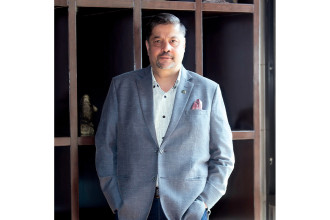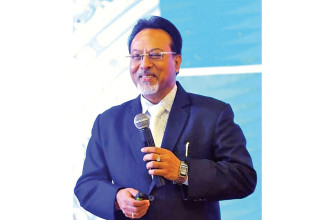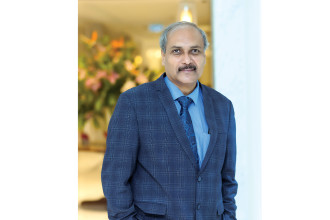
Ruth A Shapiro, PhD
Co-founder and Chief Executive
Centre for Asian Philanthropy and Society, Hong Kong
Ruth A Shapiro, Co-founder and Chief Executive of the Centre for Asian Philanthropy and Society (CAPS), was recently in Kathmandu as the main resource person to speak at a programme organised to disseminate information about the Doing Good Index 2022. The programme was organised by the Chaudhary Foundation to help understand the relevance of the index in Nepal. Based in Hong Kong, Shapiro has also authored and co-authored a few books like Pragmatic Philanthropy: Asian Charity Explained and Building Energy Efficiency: Why Green Buildings are Key to Asia’s Future. Shapiro’s articles are published in the Nikkei Economic Review, South China Morning Post and Philanthropy Impact and she is a regular speaker on issues related to private social investment in Asia. Shapiro says that she has been interested in Asia her whole life and has spent a lot of time in various countries in this part of the world. “There is something fascinating about the cultures and the people and communities of this region and it also has a rich history,” she shares. She likes to call herself a social entrepreneur and on the lighter side states, “I have never been good at making money because I am always driven by the mission and not the profits.” “I believe people do want to help each other and it’s a central part of what makes us human but sometimes I feel, in the modern world a lot of the natural tendencies that have helped us for thousands of years are getting eroded slowly,” she mulls. During her visit, Business 360 had the opportunity to speak to her about the Doing Good Index and its importance and other issues related to philanthropy. Excerpts:What exactly is the Doing Good Index and how is it relevant to Nepal?
Besides philanthropy, our centre also focuses on corporate social responsibility (CSR) and impact investment. We think of the ways in which private resources can be brought to bear on doing good. That can happen through philanthropy and volunteering in a number of ways. When we were establishing CAPS, I interviewed a lot of very wealthy people. During those conversations I asked them about why they were giving money to Cambridge and Harvard and other similar international organisations but what was stopping them from giving more locally. And I was very surprised to hear the same answer whether the person was in India or Indonesia or Korea. They said they didn’t trust the local non-profit organisations enough. They didn’t know what these organisations are doing so they would rather give to the aforementioned organisations because they trust them. In fact, they would also give to faith-based organisations, be it a temple or a church, because they could be trusted. We, thus, realised that throughout Asia there is a very serious trust deficit. It is not just that many governments don’t trust these non-profit organisations but companies and philanthropists also don’t. And it goes the other way too. Many non-profits too don’t trust the government or companies. This lack of trust among different sectors of society is a very big obstacle to getting things done. We have to realise the problems we are facing today are big and we need to work together but if we don’t trust each other then why would we work with each other. So, the Doing Good Index really is an effort to look at the structures, institutions, regulations and policies that strengthen or weaken the sector as a whole including the need for better transparency and accountability. How do we build trust? We do so through the efforts of being transparent and accountable. If I know exactly what you are going to do with my money, then I am more likely to give it to you. So, if you look at the Doing Good Index there are four sets of indicators. Three of them are related to the government – regulations, tax and fiscal policies, and procurement policies. One of them deals with society – how much does the society embrace the notion of helping each other; some cultures have it more than others. Taking all these aspects together we get an understanding of how the system works or does not to enable philanthropy and subsequently enable good. We have been working on this index in 18 economies but in 2022, Myanmar was not able to participate for obvious reasons. The index is also useful to compare how Nepal is faring in comparison to other countries in South Asia or other developing countries.How are you collaborating with the CG Foundation on the Doing Good Index?
In all of the countries where we publish the Doing Good Index we have a local partner because we are a relatively small organisation based in Hong Kong and we cannot have really in-depth awareness of what is going on in every place in Asia. We need to have partners who can help us and they do so in a few ways. We require over 100 surveys filled out for the index and these surveys are quite extensive and can take on average 45 minutes to fill. Hence, we need somebody on the ground that can help organisations to fill out the surveys so that we have reliable, robust data. We also ask our partners to convene expert groups to talk about these issues and these expert groups comprise of a lawyer who knows the laws and philanthropy, an accountant who knows about tax deductions, an academic, a government official overseeing the sector, among others. CG Foundation helps us collect data on the ground in Nepal so that we can tell the story of what’s happening in the country.What are your thoughts on philanthrocapitalists? Can you elaborate on the relationship between giving and business interest and the agency associated with capitalist philanthropy?
There are a number of definitions of what a philanthrocapitalist means. I believe it is ‘what is the relationship in giving in business’. We are now beginning to come out of the pandemic and what happened during that period is that it did not create any new trends but accelerated existing trends. Some of those trends were good like the increased use of technology and local efforts to engage with the people. However, there were many bad trends too like increased income disparity and increased educational disparity, to name just a few. Given these trends of broadening disparities plus climate change there is a growing recognition that governments by themselves or non-profits by themselves cannot fix all these problems. And what is happening is that companies are being asked not only by governments but also by society on what they are doing for the community, what they are doing to fix the problems. Milton Friedman, a famous economist of the United States, used to say that the only responsibility of a company is to its shareholders. Nobody says that any more, it’s passé. Now there is a growing recognition that companies have to think about their other stakeholders. So, it is no more about only shareholders but stakeholders who may not be directly linked to the company. It is not just about customers and the supply chain but also about the communities in which they are operating. There is a growing sense that companies must be part of the solution and not part of the problem and I think a lot of business leaders are starting to embrace that concept. Companies will be creating win-win opportunities when they actually address sustainability and incorporate ESG (environmental, social and corporate governance). Working in the community can provide a shared value, can create a win-win situation so that the company thrives and the people and community also thrive.Is capitalist philanthropy or the billionaire club philanthropy eroding collective action and the engagement of strong public sector? What are the repercussions if this is right?
This is quite interesting and in a country like Nepal, it could be a bit provocative statement. Is it that philanthropy is eroding community engagement or has foreign aid eroded community engagement? Because when someone is relying on foreign aid then the donors come in, give a certain amount of funds, they have their own solutions and a lot of small community efforts stop working. So, the question here could be, is it due to philanthropy? I would say no. Philanthropy is part of local community efforts but foreign aid I don’t know… though it has had enormous benefits. I think one of the positive aspects of Covid 19 has been re-engagement at the very local level. Why? Because the whole world was affected and nobody was coming from outside. The situation was such that we all had to help each other at the local level. That is actually a positive aspect. However, I also think that it is not only philanthropy or foreign aid that has eroded community engagement. I feel modernisation has eroded that… with people being busy on their devices. However, community engagement is actually coming back because I can see there has been a backlash against globalisation and a re-engagement at the local level which is a very positive thing.Private philanthropy through foundations often point to a series of challenges including lack of transparency, limited time and resources for rigorous learning and advocacy, a lack of transparency, engagement of the beneficiaries in the process and lack of accountability. What are your thoughts?
You have organisations that supply the money and on the other hand there are organisations which receive that money. But transparency has to increase on both sides. Let’s start with the ones that receive the money. We call them SDOs (social delivery organisations), which can be non-profits, social enterprises or community service organisations. They need to be a lot better at telling their stories. They need to have great websites where they have to share where the money is coming from and where it is being spent. They also have to mention the impact they have had which is very important. They can’t be just seeking more and more funds. The ones giving the money also have a responsibility. They have to ask the recipients on why they should give the money to them. Donors have to ask why they should trust the receivers. The donors could also tell their stories better like who are they funding and why are they funding. There is a concept called DIY philanthropy which has been increasing in Asia and Nepal too. It is like when companies say they have a distribution system, they have people on the ground and they have this business understanding, so why should they give money to non-profit organisations. They know how to do this work so why not do it themselves? That is fine but they need to also help people understand why they are taking the actions they are taking and I would say the government has a role here. In Nepal, the government does require organisations, foundations and non-profits to supply their annual reports to the government but the reports are not made public. Why not? I would prefer the government to put those reports on their website. It is great that the government has the reports but what about accountability, letting everyone know. If you are going to collect the data, then why not make them available so that everybody is aware of the reports.
How can we engage the last mile during any philanthropic work?
Well, there are a few points to that question. What is the role of philanthropy? Some people say it is just to cover the last mile. It is to reach where the government cannot help and that is true. So, you need to understand how you are going to be able to do something that the government cannot do. You have to be aware of what the community needs, that’s very important. The second is philanthropy is sometimes called risk capital because we need innovation, new ideas. We need new ways of addressing climate change, education disparities and rural health challenges and sometimes some business people have a pretty sophisticated understanding of business tools and ideas and they can use that understanding to pilot new ways of doing good and take that risk because it is their money. A really successful project is when a philanthropist takes risk in a new way and the government picks up that intervention and rolls it out. I can give you an example. In Malaysia, there is a company which felt like they could improve how schools are being operated using business thinking. They developed a model that was student centric rather than the teacher being at the centre of the classroom. It was more like peer learning. They developed a whole new strategy to work in schools and they told the government they would first try it out in 50 schools and they did it. What happened was the test scores went up and the confidence level of the students rose because the students were participating more. There were a lot of other successful indicators too and the Malaysian government has rolled out that strategy in three provinces. They plan to roll it out across the country. This is an example of philanthropy combining with the business understanding of the donors to better the community. That’s a really good example of risk capital, trying out new innovations.What is your understanding of the statement: Philanthropy in the first world and the third world are two different things?
I think it is a human tendency for people to want to help each other no matter where they are but the type of help that is needed can differ. There are wealthy people in Nepal and there are people who are middle class. What you have to realise is you don’t have to be super rich to be philanthropic. I am sure all of us donate money, whether a big or a small amount, to some causes from time to time. I am not rich but I do. So, it is about people who are helping those who do not and that’s true everywhere in the world. I don’t think it is a rich versus poor thing. I think there is a slight difference between the East and the West, whereby you will notice in the United States and Europe people do not engage much with the government. In Asia, government needs to be part of the solution. It needs to be at the table right from the beginning and I think that is good because you cannot scale change without government. So, I would make that distinction.Could you tell us a little about your understanding of China’s philanthropy processes?
China has a very different system than Nepal. In China, it is more like an orchestra. The Chinese communist party writes the music and they are the conductors and can say now let’s play the violins, now the flutes and now the clarinets. They are the conductors and the different sections of the orchestra are the private enterprises, the people. The government coordinates everything, hence the music is coherent. It comes together. I don’t think the government of Nepal can do that in the same way. But what can be learnt from China is the degree of coordination that happens. I think that different sources of capital, whether they are foreign aid organisations or a company or an individual, they have different strengths. Some really understand the business side, some understand engaging with the public and the government can play the role of the project coordinator a little bit more like helping to make suggestions as to how funding is routed so that it is complimentary and not contradictory. That can be learnt from China.What does philanthropy mean to you personally?
The golden rule of life is ‘Do unto others as you would have them do unto you’. That is what philanthropy means to me. We have to keep that as our North Star and I am afraid sometimes we forget that. We have to care about each other. We have one planet and it is getting smaller all the time and it is facing problems that are bigger than any one of us or any individual country. So, philanthropy means helping, reaching out and doing unto others what you would want them to do for you.There are often talks that CSR of some companies borders on marketing. What exactly would you define as CSR and how does it contribute to society?
I don’t have a problem if a company is doing great work for the community and it tells the story of it doing that good work. Even when we are about to choose between buying a cracker from one company or another and you know that the second company uses some of its profits in the community, then you might choose that cracker. So, I don’t have a problem with companies telling the stories of the good they are doing. The question now would be if they are making that cracker by treating their employees terribly or putting bad ingredients into that cracker. If so, then whatever they are doing in the community doesn’t matter that much. It would be a greenwashing or whitewashing kind of effort that is problematic. However, if they are doing really good work and they want the community to know about that then I am okay with it. I think that many companies now are really grappling with that scenario. All of a sudden, the terrain has changed. We have moved from responsible to the shareholder concept to responsible to the stakeholder concept pretty quickly, so companies have to now change their systems. You have to think beyond your profits. You have to think about ESG, which is also a pretty new concept. So, it is now more about how do I treat people. I think companies which embrace these topics and actually engage in finding ways to help the community will in turn also help the business. If you can find those win-wins it is the best because it is good for the company and also the community and it will be more sustainable over time. You are not giving money as a one-off, it becomes part of your business model.It is really difficult at times to differentiate between an entrepreneur and social entrepreneur. What are your thoughts?
This query is pertinent because even as I speak you will realise the answers seem to be blurring. But there is no company now that can say they do not care about the community. Nobody can say that. Every company has to say that of course they care about the community. Hence, if you are an entrepreneur now you have to incorporate these values into who you are. What does it mean to be a social entrepreneur? I think that is a tricky question. For a social enterprise or social entrepreneur, the impact comes before the profit whereas for an entrepreneur the profit may come before the impact. But for both types of entrepreneurs, they need to care about profit and impact. It is just about creating the right balance. I would like to add that every time I come to Nepal, I am so impressed by the people mostly. People here are kind and compassionate and there is a real history of local groups and communities helping each other. My message would be that this a key strength operating in the country but during the goal to modernisation Nepalis must not forget their DNA; who you are and what the beautiful kind of community and caring characteristics that make up what is Nepali people. READ ALSO:- 'I was recently at a banking and finance conference in Kathmandu and it was an eye-opener for me'
- ‘We wanted to do something meaningful to raise the bar of sports in Nepal’
- ‘As long as Gulf governments subsidise their airlines, we can never talk of a level playing field’
- ‘All stakeholders need to come together and work on innovative schemes’
- RUDRAKSHA: SHIVA’S TEARS OF JOY
Published Date: January 4, 2023, 12:00 am
Post Comment
E-Magazine
RELATED Face 2 Face





